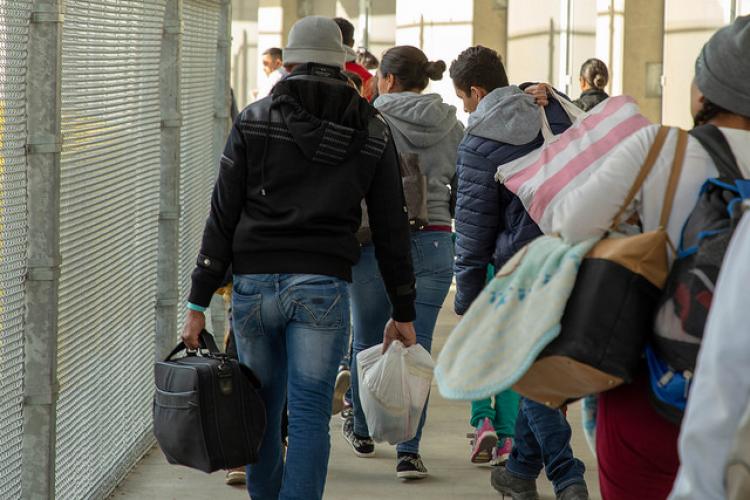You are here
Asylum Hangover? Governments Seek to Narrow Avenues for Humanitarian Protection

Outside the Moria first reception center for asylum seekers, Lesvos, Greece. (Photo: Nonviolent peaceforce/Flickr)
Faced with absorbing vast numbers of asylum seekers who headed to Europe during the 2015-16 migration crisis and the ongoing arrival of much smaller, but steady flows of Central Americans at the U.S.-Mexico border, EU Member States and the United States in 2018 took or explored steps to narrow asylum and harden policies.
Some moves, such as Denmark’s decision to isolate a small number of failed asylum seekers on a deserted island, seem less about restoring order to the asylum system and more about conveying a tough message to would-be migrants and domestic constituencies that are exhibiting rising support for nationalist, anti-immigration political parties.
|
Issue No. 7 of Top Ten of 2018 |
Others represent a significant reshaping of asylum policies, such as steps undertaken by the Trump administration to significantly narrow grounds to claim protection and the August enactment of an asylum and migration law in France designed to shorten asylum application deadlines, increase detention for asylum seekers, and expedite return for those who do not qualify.
In the United States, President Trump in November issued a proclamation restricting access to asylum for those entering the country illegally—a step particularly significant at a time the government is limiting the border ports of entry where asylum claims can be filed and the number of cases accepted each day, with resulting waits of weeks or more in Mexico. Quickly stayed by a federal judge, the administration’s plan appears headed to the Supreme Court. (See Issue #3: Shaping a Narrative of "Crisis" at Border, Trump Administration Takes Muscular Action.) Separately, the United States is pressing Mexico to agree to a formal “Remain in Mexico” plan that would require asylum seekers to wait there while their cases are processed.

Processing of migrants, some seeking asylum, at the San Ysidro port of entry, November 2018 (Photo: Mani Albrecht/U.S. Customs and Border Protection)
Across the Atlantic, asylum remains a difficult, complex issue for the European Union and its Member States amid a continued inability to overhaul a dysfunctional Common European Asylum System and ensure a more equitable distribution of asylum seekers across countries. In a showdown with Hungary, which in June passed a law that would make it a crime to help asylum seekers, the European Commission in July referred the country to the European Court of Justice over other asylum provisions. In Italy, the Deputy Prime Minister and leader of the far-right League party, Matteo Salvini, and allies pressed for enactment of a decree limiting rights to asylum and tightening immigration rules, quelling opposition to the package by calling—and winning—a confidence vote in November. And in Germany, where politics have taken a more conservative turn since the country accepted 1 million asylum seekers in 2015, one of Chancellor Angela Merkel’s would-be successors floated the idea of removing the right to protection guaranteed in the constitution.
Beyond changing or seeking to amend rules to apply for asylum on European soil, some European leaders made clear their interest in shifting the EU focus to assisting vulnerable migrants in countries of first asylum. Austria and Denmark in October jointly presented a plan offering economic assistance to countries closer to the conflicts spurring displacement and tougher EU border enforcement. And elsewhere, EU and national leaders are intent on striking partnerships with migrant-transit countries in North Africa and beyond to curb irregular migration and facilitate returns. (See Issue #6: Intensifying Focus on Migrant Returns Takes a More Global Stage.)
As governments on both sides of the Atlantic grapple with the politics of migration and asylum while far-right populist parties successfully use immigration as an ingredient in their recipe for increased clout with restive publics, it seems clear that more changes will be in the offing in 2019.
Recommended Reading
- What Is the Current State of the Migration Crisis in Europe?, The Guardian
- Migration to Europe in Charts, BBC News
- How the U.S. Asylum System Works, WBUR
- Trump Claims New Power to Bar Asylum for Immigrants Who Arrive Illegally, New York Times
- In Search of Sustainable Approaches to Migration, EU Strives for Partnerships, IPI Global Observatory
- Europe Wants to Process Asylum Seekers Offshore—The Lessons It Should Learn from Australia, Brookings Institution
- EU asylum reform vision paper, Austrian Minister of Interior and Danish Minister for Integration


